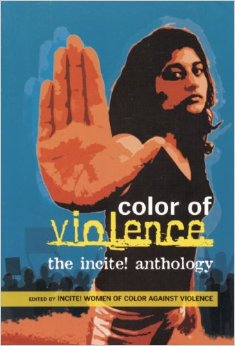WIN Reviews

Violence and Women of Color
Color of Violence: The INCITE! Anthology
by INCITE! Women of Color against Violence
South End Press, 2007.
260 pages; $18, paperback
The radical feminist activist group INCITE! was born out of the “Color of Violence” conference in April 2000. The conference sought to address the failures of racial justice and antiviolence organizations to effectively address violence against women of color. Participants met to develop analyses and strategies that put women of color at the center. The results are presented in Color of Violence: The INCITE! Anthology, a collection of stories, poetry, academic writing, letters, and manifestos.
When we sat down to collectively write this review, we found ourselves sharing our favorite pieces, teasing out key ideas, talking about phrases that stuck with us, thinking about our experiences within progressive and radical organizations, and rethinking violence in our lives. Through this process, we discovered two themes that run through the book. First, we noted that state violence, and what the state offers as solutions to violence — “better” police, state-funded shelters, and more jails — are intimately intertwined with, and create, interpersonal violence. Second, shared oppressions —- as women, as Black folks, as queer folks — are not enough of a foundation to effectively fight violence against women, let alone to create a world we want to live in. Instead, as many of the anthologyís authors argue and our experiences confi rm, failure to recognize this has paralyzed and damaged antiviolence movements.
Violence & Anti-violence Strategies
Today in the world… U.S. soldiers and U.S.-backed Iraqi forces rape Iraqi women… Japanese government says women “not forced” into sexual servitude during WWII… Angelina Jolie adopts another exotic Third World baby girl…
Too often, violence against women is characterized as a private and localized issue in the form of rape or physical abuse. This analysis does not address how state-perpetrated (and perpetuated) violence creates conditions for domestic violence, and how state violence is also violence against women. The authors represented in Color of Violence explode the false idea that domestic abuse is the predominant form of violence that women face. They uncover the violent realities that many women of color live — without healthcare, childcare, education; in poverty; in resource-poor communities; and with police and jails as the only well-funded form of governmental investment.
Even movements for justice are at times perpetrators of violence against women of color — for example, Loretta J. Ross, in “The Color of Choice: White Supremacy and Reproductive Justice,” writes about how in its history the pro-choice movement has ignored white supremacy, and how it has actively worked to constrain the reproductive rights of women of color, and especially among the poor. Other authors detail other examples of state-created and perpetuated violence against women.
In “The Complexities of ‘Feminicide’ on the Border,” Rosa Linda Fregoso links the murders of poor, darker-skinned women in Ciudad Juarez, Mexico to destructive processes of globalization, and to state-sponsored policies of terror, violence, and extermination of all forms of dissent. These nearly 400 violent rapes and murders continue with impunity, marking the state’s disregard and dehumanization of poor, darker-skinned women.
Nadine Naber, Eman Desouky, and Lina Baroudi explain how the Israeli genocide of the Palestinian people is directly tied to racism and gender-based violence against women.
Militarization of the U.S.-Mexico border has made women vulnerable to rape and sexual assault by Border Patrol officers, as detailed by Sylvanna Falcón.
Building movements
How do we effectively organize together? Andrea Smith offers us some guidelines in “Heteropatriarchy and the Three Pillars of White Supremacy: Rethinking Women of Color Organizing.”
Smith writes that the “premise behind much “women of color” organizing is that women from communities victimized by white supremacy should unite together around their shared oppression.” This is a flawed premise, she continues, because it falsely assumes that our communities have been hit by white supremacy in the same ways, and that strategies for liberation will be similar for all communities. It also ignores the ways that communities are not only victimized by white supremacy, but are complicit in it as well.
The solution, she argues, is to have “alliances [that are] not solely based on shared victimization, but where we are complicit in the victimization of others.” This process has the potential to keep us all accountable ñ not just in keeping promises that we make, but in actively learning about each otherís struggles and
complicities through interacting with each other. Through this process, we can create solutions that donít negate any of us.
The INCITE! anthology does just that. It’s a manual for people who want to address the myriad forms of violence that affect our communities. It is a textual relationship that you can interact with and grow with. It is not meant to be read once and then forever consigned to gather dust in some university library. Rather, it’s meant to be used, re-read, brought up in conversation, and struggled over. It’s meant to be translated into action, knowing that what we do will be replete with contradictions and inadequacies, but that weíll continue to attempt to resolve them.
Our responses to the anthology are informed by our similar experiences as first generation born-in-the-US Chinese American women who are college-educated, middle and upper class, and working and organizing in New York City; and by our identities, respectively, as queer and as straight. You will undoubtedly draw conclusions of your own — but only, of course, if you read the book.
